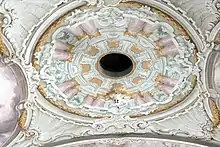Holy Ghost hole
A Holy Ghost hole, or Holy Spirit hole, is a circular opening in the ceiling of a church which symbolises the descent of the Holy Spirit on a congregation. They are typically decorated with Pentecostal motifs, such as doves, rays of light, and flames. The holes are often covered by latticework or a wooden lid which is only opened during Pentecost. Alternatively, the hole may be permanently left open, displaying a dove figurine or other depictions of the holy spirit.

During Pentecost sermons, a dove figure is often suspended from the ceiling and lowered through the opening. Live doves may have previously been released from the openings during the Middle Ages.[1] Today, flower petals may alternatively be released from the ceiling through the hole and onto the congregation below, symbolising the "tongues of flame".
They were most commonly built in churches during the Middle Ages, though classicizing architectural elements often replicate their appearance. Other features of church architecture which are similarly built into the apex of a ceiling or dome closely resemble Holy Ghost holes, such as oculi. Organ sound-holes, in particular, were often decorated or disguised as Holy Ghost holes.[2]
Gallery
 Holy Spirit hole hung with a wooden dove, Saints Peter and Paul parish church in Söll.
Holy Spirit hole hung with a wooden dove, Saints Peter and Paul parish church in Söll._St._Michael_Heiliggeistloch_829.jpg.webp) Holy Ghost hole depicting the Eye of Providence, Church of St. Michael, Ziegelbach, Germany.
Holy Ghost hole depicting the Eye of Providence, Church of St. Michael, Ziegelbach, Germany. A Holy Ghost hole covered by a painting of a Pentecostal dove, St. Vitus church in Donaualtheim, Germany.
A Holy Ghost hole covered by a painting of a Pentecostal dove, St. Vitus church in Donaualtheim, Germany..jpg.webp) Gothic Holy Ghost hole framed by 15th-century frescos at Church of the Holy Spirit, Heidelberg.
Gothic Holy Ghost hole framed by 15th-century frescos at Church of the Holy Spirit, Heidelberg. A dove figure with "tongues of fire" suspended through a Holy Ghost hole, Kapelle Schanz in Ebbs.
A dove figure with "tongues of fire" suspended through a Holy Ghost hole, Kapelle Schanz in Ebbs. Holy Ghost hole covered by wooden latticework, St. Vitus and Katharina in Rehling.
Holy Ghost hole covered by wooden latticework, St. Vitus and Katharina in Rehling.
References
- Lipsmeyer, Elizabeth (1995). "Devotion and Decorum: Intention and Quality in Medieval German Sculpture". Gesta. 34: 20 – via JSTOR.
- Del Prete, Michele (2017). "Sound Thresholds: Visual and Acoustic Values of the Fernwerk in Post-Romantic Organ Building and Architecture". Music in Art. 42: 247 – via JSTOR.